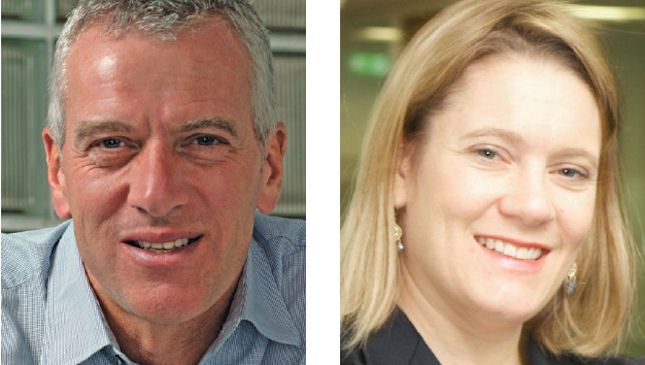01 June 2014

Top left: Neul CEO Stan Boland is pitting open source against a proprietary French network from Arqiva. Top right: Arqiva’s M2M MD Wendy McMillan is used to working with rival companies on exploring mutually “interesting” projects.
BT has teamed up with open source machine-to-machine (M2M) equipment supplier Neul to supply a city-wide test-bed for Internet of Things (IoT) applications in Milton Keynes. It has invited interested parties to get in touch with project ideas.
The news came less than a week after wireless infrastructure supplier Arqiva said it had joined Sigfox, a French competitor to Neul, in setting up a 10-city IoT network, and shortly after UK start-up Senaptic announced plans to build specialised, ‘cellco-free’ IoT networks for specific customers and segments.
Neul CEO Stan Boland said the Milton Keynes system is based on the Weightless open communications standard for the IoT (see News, Nov 2013). The standard has attracted over 1,400 member companies and is backed by ARM, CSR and Accenture. “Weightless was developed specifically for the Internet of Things. Though initially targeted at TV white space spectrum, this has now been generalised for other sub-1GHz licenseexempt bands. Open standards and ecosystem collaboration are a requirement to make the IoT a reality.”
Boland says the first of 1,000 planned sensors will be installed in June and connected by an initial 12 base stations that cover most of Milton Keynes. Backing for the project comes from the Connected Digital Economy Catapult, Future Cities Catapult, Milton Keynes Council and The Open University.
Meanwhile, BT and Arqiva are already partners in a consortium with US-based Sensus and Detica to provide the £625m smart meter network for 10 million homes in Northern Britain, while Telefónica scooped the rest of the country with a £1.5bn bid (see News, Jul-Aug 2013).
Arqiva MD for smart metering and M2M Wendy McMillan played down suggestions of a rift between the two network operators: “BT is both a customer and a supplier, a partner and a competitor, so we are used to working together in many different ways and this does not impact our relationship in any way,” she told Networking+.
She declined to say whether Arqiva spoke to Neul before signing up with Sigfox, which provides proprietary ultranarrow band radio technology in the 868MHz or 902MHz bands. “We regularly meet with a number of companies in the various sectors we work in, and while competing in some instances, there are also a number of overlaps that are interesting to explore together,” she said.
The cities in the Arqiva-Sigfox network include Birmingham, Bristol, Edinburgh, Glasgow, Leeds, Leicester, Liverpool, London, Manchester and Sheffield. They will also have access to Sigfox networks in France, Holland and Spain, as well as other cities, including Moscow and Munich.
All these IoT initiatives are likely to pose a threat to mobile network operators such as Vodafone and Telefónica who are targeting the M2M market. Caroline Gabriel, research director at consultancy Maravedis-Rethink, says: “The cellco community will need to respond to these developments not just with the lure of its controlled licenced spectrum, but with a network that is better suited to IoT applications than LTE in its current form.”










